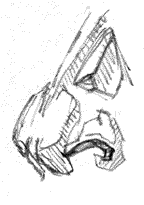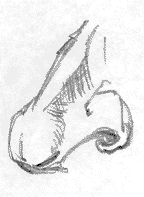
The Supply Store
Back to YouCanDraw .Com
Lesson 11: Noses |
Noses. When I think of noses I think of Jimmy Durante, or W. C. Fields. I think of Roman noses or Cirano Deberjirac. Bottle-nosed dolphins, Rudolf the "Red-Nosed" reindeer, Pinocchio...just some other notable noses. Unlike the more inconspicuous ear, people are much more remembered for their noses. People occasionally say "he has big ears" but it seems a big nose gets a lot more publicity. Your boss might be nosy. You might have a nosy neighbor.
The Latin for nose is "rhino". Rhinoceros suddenly makes sense to me. Doctors do "rhinoplasty" (a nose job), or you get "rhinorrhea" (a runny nose). You see "nose" in the middle of "Gnostic" which means "to know". Sherlock Holmes sniffed out his clues. "I smell the blood of an Irishman" Jack's beanstalk buddy would say. The nose knows. There's even a web site called "the Nose". (And believe it or not, it's dedicated to and for caricaturists. Amazing.) Schnozola, beak, snout, noggin, and kisser, all aliases for the subject of today's lesson.
Click here for a quick animated preview of this lesson
For an overview of this Lesson: |
Anatomic Foundations of the Nose
Front and center on the front plane of the face: the nose. It's wedge-like in shape. It's root is in the forehead. Has it's base in the upper lip - right in the middle. It's connected to the lip by the philtrum, the narrow canal-like thing that's always wet on a little kid.
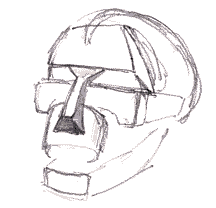
Sketch of the noses' place on the face
The nose gets larger as as you move away from the forehead. It gets bulkier too. At it's base it's held up by cartilage from the bony septum and buttressed on it's sides by more cartilage.
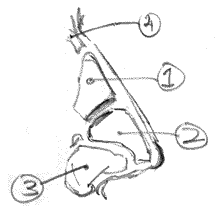
The cartilages of the nose
The Lateral Alar Cartilages ( two)
The Greater Alar Cartilages (two at the the tip)
the Lesser Alar Cartilage (cartilage of the wings)
The Nasal Bone
The "nasal" bone is almost a misnomer because it only courses through the top third or fourth of the nose. It's more an extension of the forehead. (See #4 in the illustration above.)
Six cartilages, grouped into three pairs, compose the lower two thirds of the nose. They're three mirror-image pairs: the upper pair are called the Lateral Alar Cartilages.
The lower pair of cartilages compose the wings of the nostrils. They're called the Lesser Alar Cartilages.
The tip of the nose is built around the Greater Alar Cartilages. This pair of cartilage shapes the tip of the nose and divides the noses' internal cavity in half. George Bridgman, the famous art teacher from the turn of the century, depicted the tip of the nose as a single entity - not as a pair of cartilages. I think of Carl Malden's nose when I want to think of a good example of a "split tip". Technically, for drawings sake, think of the tip of the nose as a single unit - but know that it can have obvious, bulbous divisions.
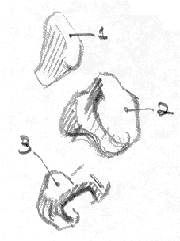
Exploded view of nasal Cartilages
The Lateral Alar Cartilages (the middle wedge of the nose).
The Greater Alar Cartilage (the tip).
The Lesser Alar Cartilage (cartilage of the wings or nares).
The General Shapes of the Nose
There are three general shapes within the nose: a wedge at the bridge of the nose that opens wider towards the nasal root at the forehead. A second wedge in the middle part of the nose that narrows as it joins the bulbous tip (the third shape). Within the bulbous tip I include what's really a fourth shape: the flared sides at the base of the nose - the nares or "wings" of the nose. (Kids are shameless about using these the last two parts. Adults are more discreet - like only in their cars when they think nobody's looking or they won't admit it all. Danged grown-ups.)

The three general shapes of the nose
The wedge shape at the base of the skull.
The middle wedge shape.
The bulbous tip of the nose (which includes the nasal wings or nares).
The three general shapes of the nose match entirely, their underlying cartilages. Learn the general shape of those cartilages and you'll see their shapes in everybody's nose.
[*If you're going through the lessons in order (Foundation lessons, ears, nose, eyes, etc.), you'll see some repetition. So e.g., if you jump right into "noses - pure contour", the complete lesson will be there. It also takes some of the load out of authoring everything from scratch. The repetition you get can only strengthen your basic drawing skills - you'll be a better caricature artist for it! If any additional explanations are needed or if there's short fallings in individual lessons, I can always make additions - None of this is written in stone and I have a huge amount of disc space rented to make this as comprehensive as possible. -jk.]
Time
to draw Noses: |
Some nose illustrations for you to review, to try to draw, to enjoy.
1.
2. |
3. |
4. |
5. |
Kasbohm & Company's
YouCanDraw.com
© Copyright, All rights reserved 1997
e-mail: jeffkaz@YouCanDraw
